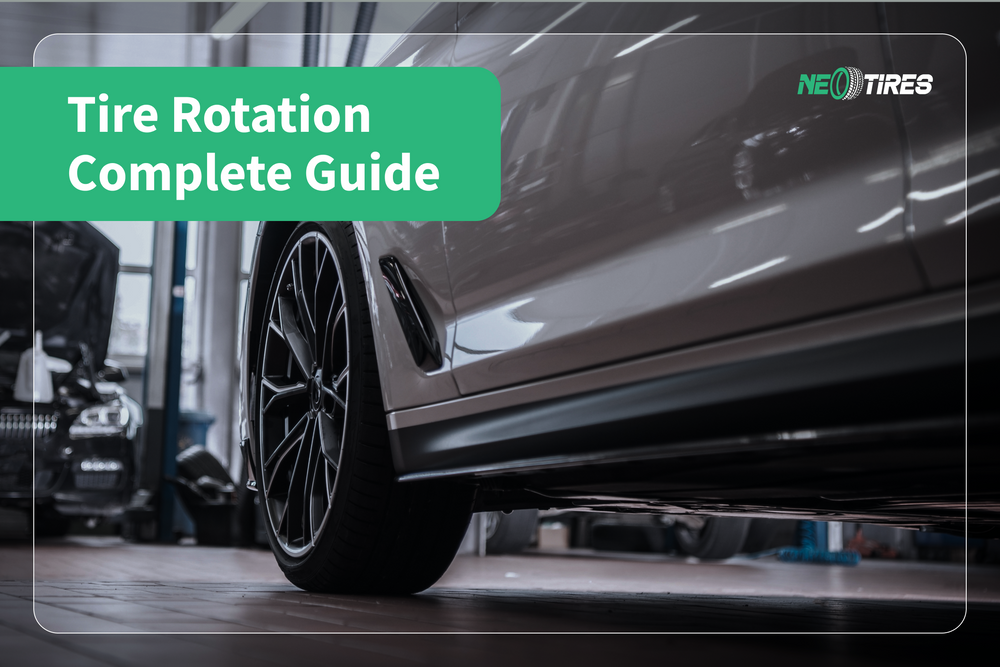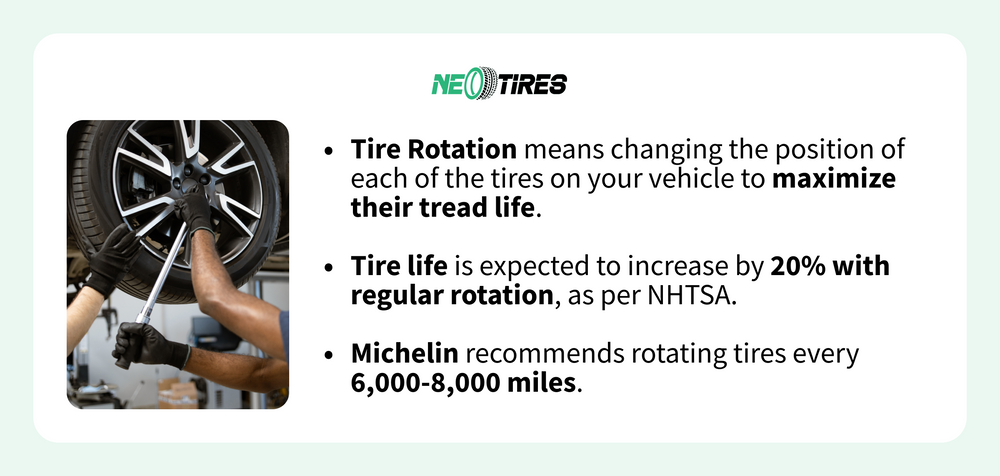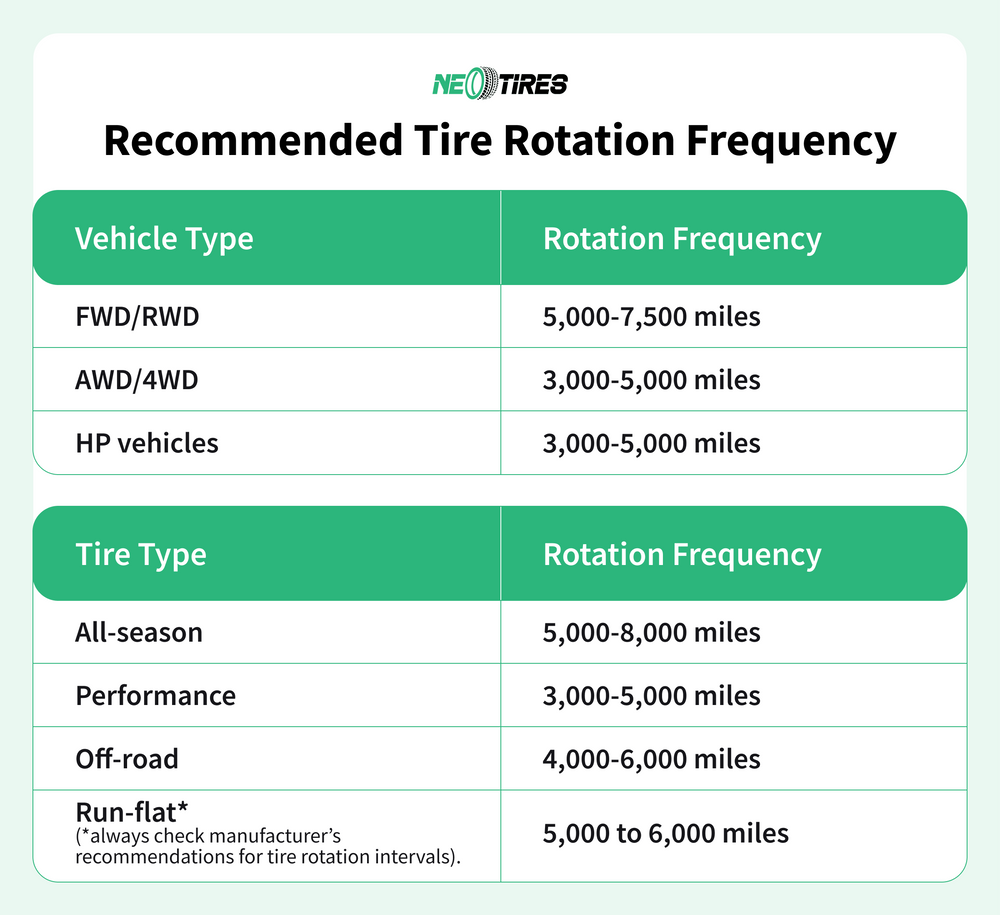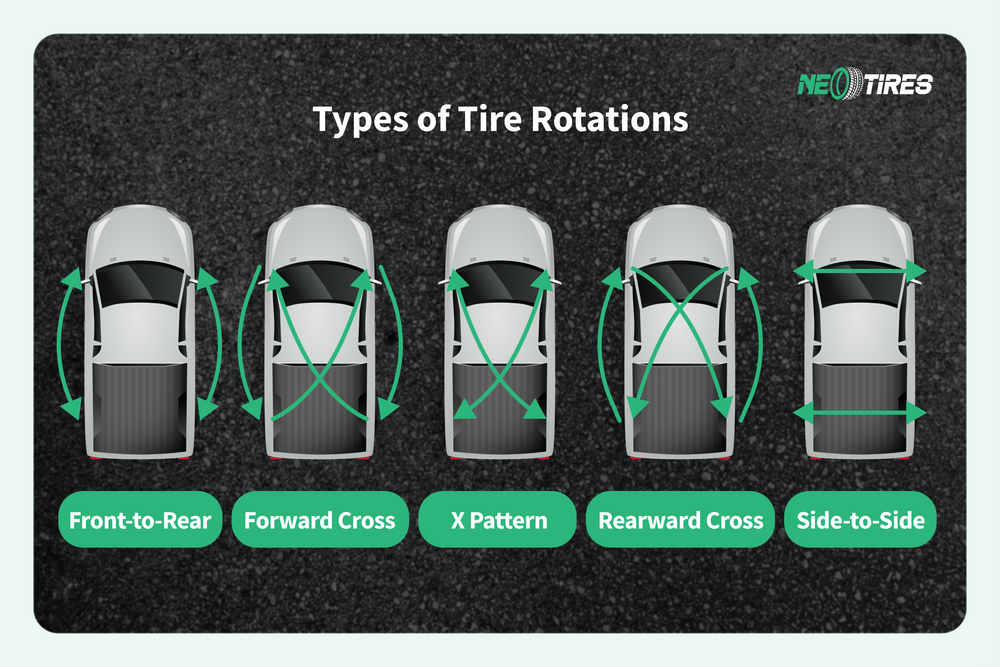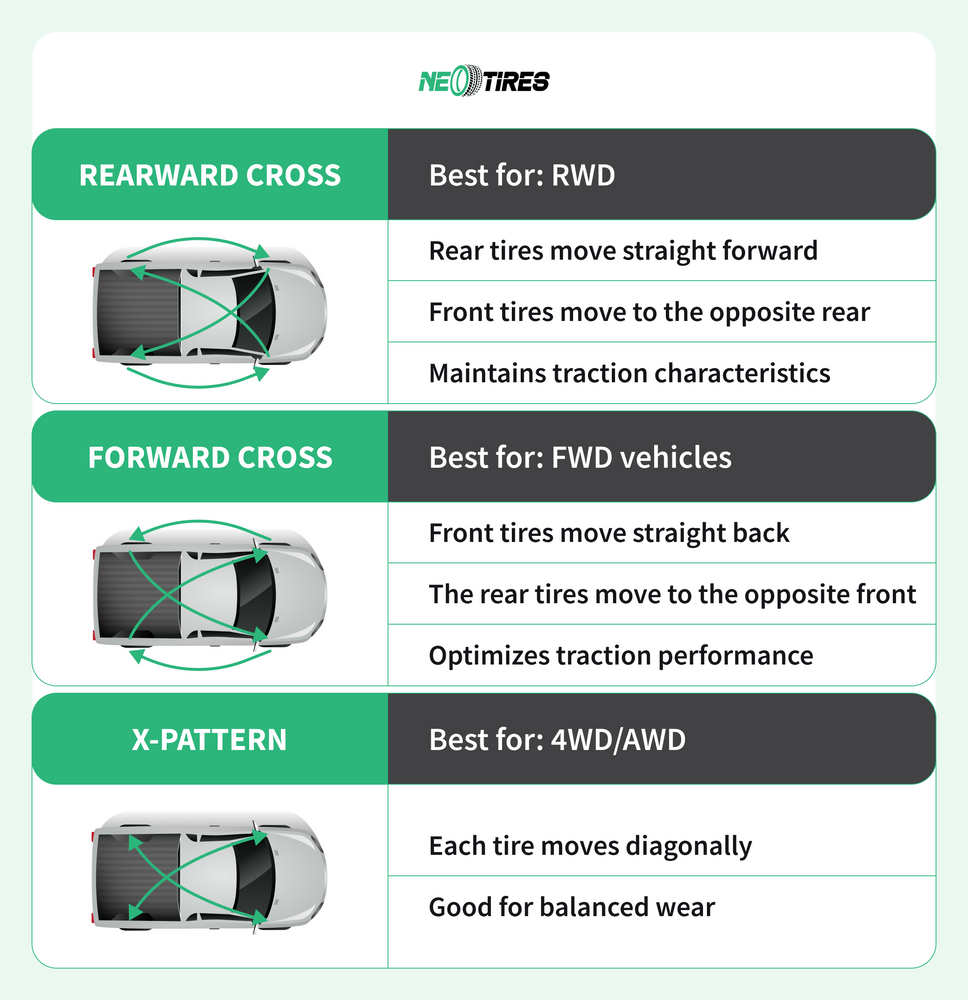Tire rotation is a vital tire maintenance procedure that involves changing the tires' position on the vehicle's axles. This systematic procedure is necessary to even out tire wear, increase tire longevity, and enhance vehicle performance in terms of handling, fuel efficiency, and safety.
According to Michelin, tire rotation should be done every 6,000-8,000 miles. It helps prolong tire life by 20% (NHTSA). The average cost of tire rotation is between $35 and $45.
What is Tire Rotation?
Tire rotation is the systemic swap of automotive tires between vehicle axles to optimize even tread wear. The tires rotate according to specific patterns like cross, front to rear, or rear to front. Changing tire position regularly (every 6,000-8,000 miles) helps reduce the stress on the tread wear and maximizes tire life and performance.
What does Tire Rotation Do?
Tire rotation helps with:
- Performance Optimization
- Tire rotation reduces the impact of position-specific areas;
- Maintains the consistency of handling capabilities;
- Ensures balanced traction in all 4 wheels.
- Wear Distribution
- Provides uniformity of tread pattern of all tires;
- Compensates mechanical variations and balances the weight distribution between all 4 wheels.
- Reducing Common Tire Issues
- Reduces risk of flat spots;
- Minimizes the probability of tire premature failure;
- Decreases tire noise and vibration.
Is Tire Rotation Important?
Yes, tire rotation is important as it extends the tire life by 20%, protects the warranty, increases vehicle handling, and lowers tire vibration or noise.
- Extending Tire Service Life:
According to the NHTSA, timely rotation extends tire serviceability by up to 20%. This significantly benefits drivers in terms of money savings through reduced replacement frequency.
- Warranty Protection:
Correct and timely rotation is an essential clause for most warranties. Drivers are encouraged to keep the rotation service documentation to maintain the validity of the warranty. In most cases, drivers must rotate once every 6,000-8,000 miles, depending on the vehicle, tires, and driving conditions.
- Safety Advantages
Tire rotation contributes to the vehicle's consistent handling characteristics, even if not directly. It increases the ability to ensure optimal traction in various road and weather conditions. Due to the even wear ensured by rotation, risks of hydroplaning in wet conditions, vibrations, and steering issues decrease.
- Performance Optimization
Better handling, lower vibration, and noise optimization are likely with tires rotated on time. Properly rotated tires provide uniform rolling resistance which also optimizes fuel consumption.
How Often Should You Rotate Your Tires?
The ideal time to rotate tires is every 6,000-8,000 miles (9,656-12,875 km) or every 6 months. The time can vary based on driving habits or purposes, so consider the below two rotation intervals as per the driving conditions:
- Rotate tires sooner (3,000-4,000 miles) if driving aggressively, carrying loads on commercial vehicles, in case of early uneven wear, or driving horsepower cars with staggered tire setups. Also, consider early rotation in the case of AT, off-road, and any tires with aggressive patterns.
- Delay tire rotation (7,000-8,000 miles) if driving in even-wear driving conditions, consistent climate, smooth braking and cornering, and occasional driving.
How To Do Tire Rotation?
Tire rotation can be done at home or by visiting a qualified tire rotation service center. To do a rotation at home, follow the below seven steps:
- Determine the rotational pattern for your tires;
- Position the vehicle on level ground and make sure the parking brake is engaged;
- Use a lug wrench to loosen the lug nuts before lifting the vehicle off the ground;
- Lift your vehicle with a jack. We recommend opting for a jack for at least 3/4 of your vehicle's weight for an adequate safety margin;
- Remove the tire safely after loosening the lug nuts;
- Replace the tire according to patterns and torque to specifications;
- Make sure to tighten the lug nuts as required after finishing the process.
NeoTires recommends addressing a qualified service center for professional procedures. Professionals will inspect them for you to identify any potential damage. Always understand the tire rotation pattern as per your vehicle or tire type.
Tire Rotation Patterns
Tire rotation standard patterns depend on the type of vehicle and include Rearward Cross, Forward Cross, and X-pattern schemes. The Rearward Cross is generally best for RWD vehicles, while the X-pattern best matches 4WD and AWD cars (as per Bridgestone). The forward cross is best for FWD vehicles.
Specialized rotation patterns are applicable for directional tires, high-performance tires, and when the rotation of the full-size spare tire is included. Directional tires can only be moved Front-to-Back while remaining on the same side of the car. Performance tires undergo a Side-to-Side pattern when the front and rear axles have different tire sizes.
Rotation, including the spare, full-size tire, can be Rearward Cross (for RWD/4WD) and Forward Cross (FWD cars) with non-directional and same-size tires. Rotating the full-size tire ensures even tread wear across all the vehicle’s tires. The rotation patterns look as follows:
Standard Patterns (source Bridgestone)
Rearward Cross
Best for: RWD
Rear tires move straight forward
Front tires move to the opposite rear
Maintains traction characteristics
Forward Cross
Best for: FWD vehicles
Front tires move straight back
The rear tires move to the opposite front
Optimizes traction performance
X-Pattern
Best for: 4WD/AWD
Each tire moves diagonally
Good for balanced wear
Works with most vehicles
What Are The Tools Required To Do Tire Rotation?
There are five tools required for tire rotation. These are:
- Jack and Jack stand;
- Impact wrench or lug wrench;
- Wheel chocks;
- Torque wrench or torque stick;
- Tire pressure gauge.
How To Rotate Tires With One Jack?
To rotate tires with one jack, follow the below five steps:
- Lift the front right vehicle corner;
- Remove the wheel by loosening the lug nuts;
- Move it to the rear right corner;
- Continue pattern until complete rotation;
- Check the torque for all wheels and adjust if necessary.
How Long Does It Take To Do Tire Rotation?
On average, tire rotation at professional tire centers like Les Schwab takes 30 minutes. Adding balance, alignment, and oil change can take up to 2 hours. Vehicle complexity can influence the timing, ranging from 20 minutes for compact cars to 1 hour for specialty vehicles.
A novice car owner can complete the rotation at home in about 1-1.5 hours, and an experienced driver can take up to 45 minutes.
What Is The Cost of Tire Rotation?
The average cost to rotate tires is 35-45$ (as per Repairpal). The price for tire rotation can vary depending on the vehicle type, service complexity, tire specs, and regional variations. Standard vehicles cost $35, SUVs $50, and luxury vehicles about $60. You can learn more about How Much Does a Tire Rotation Cost? in our extended article.
Things To Ensure After Tire Rotation
The below six things should ensured after every tire rotation:
- Ensure Correct Torque
- Check Tire Alignment
- Perform Tire Balancing
- Ensure Correct Tire Pressure
- Reset TPMS
- Update Service Record
1. Ensure Correct Torque
Make sure the lug nuts are tight enough. Tighten it with a manual torque wrench until you hear the 'click' sound indicating you've reached the right amount of torque. You can damage the stud or the wheel hub if you go over that sound. Conversely, a too-loose lugnut (you didn’t reach the “click” sound) can cause wheel wobble or, worse, a tire falling off. Draw increased attention to this aspect following each tire rotation. Wheel detachment, uneven force distribution, and tread damage are likely.
2. Check Tire Alignment
Checking alignment following rotation is essential as the tire's new position might not fully align with the existing suspension and steering geometry. Tires are moved to positions with different stress patterns during rotation. All of them are subject to different demands and forces. Checking alignment will ensure proper vehicle control and optimal steering response and prevent early tire wear.
3. Perform Tire Balancing
Balancing the wheels along with or immediately after tire rotation helps reduce risks of vibration and contributes to even tire wear. In addition, performing these procedures together helps in evening weight distribution across the wheels. Ignoring tire balance will cancel the benefits of tire rotation because the irregular weight distribution will cause vibrations, suspension damage, and uneven wear.
4. Ensure Correct Tire Pressure
Tire pressure check/adjustment following rotation ensures even tread wear. Neglecting this step will accelerate the development of uneven wear patterns and generate handling issues. Blowout risks become eminent both in the case of over and underinflation.
5. Reset TPMS
Resetting the system following rotation will allow the update between tires and vehicle computers. Tire sensors can disconnect from the vehicle's reading system during rotation, leading to false pressure readings. Ignoring TPMS reset leads to incorrect estimations about tire pressure, which can increase risks related to underinflation or overinflation.
6. Update Service Record
We recommend that you track all your vehicle's servicing processes, including your tires. This will help you keep track of the rotation schedule, benefit from the warranty (if applicable), and increase the resale value.
Long-term Checkups Following Rotation
Specialists in the field recommend additional follow-ups 50 miles following tire rotation. In this sense, you should consider the following:
- Recheck torque
- Listen for noises
- Feel for vibrations
- Check tire pressure
These steps will help you detect any deviation following tire rotation and take measures early on to avoid aggravating the situation.
7 Common Problems that Occur After Tire Rotation
7 common problems can occur after a tire rotation. These are:
- Tire Noise
Tire noise following rotation can develop because of the new tire position on the road. This is especially common if the tires have uneven tread patterns. The new position on the axis changes the form of contact with the road, which generates unusual noise unspotted before.
The solution is to ensure proper pressure and balance the tires to suppress the noise. If the existing tires are too worn, tire replacement with new ones would also solve the problem.
2. Car Shaking
Rotation can sometimes unmask balance and alignment issues, considering the new tire position, leading to car shaking and vibrations. The solution is to ensure that the toe/caster/camber angles are correct and adjust the weight distribution by balancing the tires. In most cases, comfort and ride smoothness return following these procedures.
3. Low Tire Pressure
A tire can lose air during rotation. This is typically due to underlying issues such as small punctures, bead seating issues, or wear and tear. The solution is to reset the TPMS and adjust the pressure to the recommended levels.
4. Loose or Over-tightened Lug Nuts
Rotation can cause loose or over-tightened lugnuts, specifically when done improperly. This is caused by human error during the wheel re-installation process.
The solution is to ensure the correct torque with the wrench after rotation according to the manufacturer's recommendations. To avoid serious consequences, it is recommended that they be re-checked after a distance of 50 miles.
5. Traction Loss
Tires undergo a break-in period following rotation, which can cause a short-term traction loss. This is especially likely due to uneven tire wear patterns. The solution is to let your new tire position break in. If traction doesn’t return because of severe tread wear, replace the tires with new ones.
6. TPMS Malfunction
Tire sensors can lose connection with vehicle systems during rotation. This happens because the sensors detach from their initial position during rotation. Subsequently, the TPMS gives false readings regarding tire pressure. The solution is to reset the pressure monitoring system to restore the connection with the tire sensors.
7. Uneven Wear
Rotation can rarely cause uneven tread wear, especially when the wrong rotational scheme is applied. Tires need a specific rotation pattern depending on the FWD/AWD/RWD/4WD vehicle. The wrong rotational pattern can stress tires unnecessarily, causing uneven wear. The solution is to ensure the correct rotational pattern before the procedure and call for qualified assistance if needed.
Keep Your Tires Rolling Smoothly with NeoTires!
Timely rotation is crucial for your tires' service life. Yet, a safe and confident ride starts with well-matched, high-quality tires. Consider a new tire set if your current tires no longer perform even after rotation!
Check out our wide tire selection from trusted brands at affordable prices. You will find the right tires to match your driving needs. Need guidance? Our assistants are just one click away! Drive safe and choose your tires wisely!




